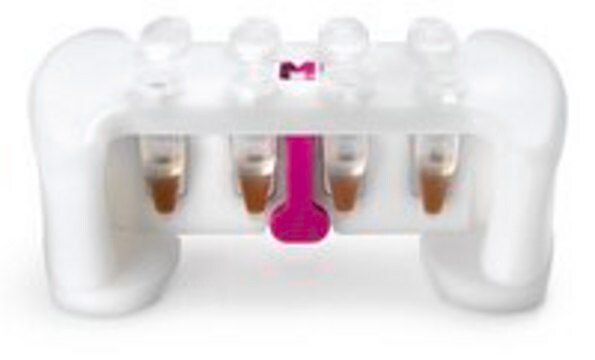15-116
ATM/Chk2 Pathway Explorer Antibody MiniPack
Upstate®, from mouse, unconjugated
Synonym(s):
A-T, mutated, AT mutated, TEL1, telomere maintenance 1, homolog, ataxia telangiectasia mutated, ataxia telangiectasia mutated (includes complementation groups A, C
and D), ataxia telangiectasia mutated protein, human phosphatidylinositol 3-kinas
About This Item
Recommended Products
biological source
mouse
Quality Level
conjugate
unconjugated
antibody product type
primary antibodies
clone
10H11.E12, monoclonal
7, monoclonal
AM9, monoclonal
species reactivity
human (05-513SP,05-649SP, 05-740SP), mouse (05-649SP and 05-740SP), rat
manufacturer/tradename
Upstate®
technique(s)
immunocytochemistry: suitable
immunoprecipitation (IP): suitable
thin layer chromatography (TLC): suitable
western blot: suitable
NCBI accession no.
UniProt accession no.
shipped in
wet ice
target post-translational modification
unmodified
Gene Information
human ... ATM(472)
mouse ... Atm(11920)
rat ... Atm(300711)
Related Categories
General description
Each Pathway Explorer Antibody Minipack contains three related antibodies as part of a signaling cascade or a combination of total and phosphorylated forms of key signaling targets. Each of the three antibodies are 30% the original pack size. Full size versions of each of the Pathway Explorer antibodies are available for sale individually under the same catalog number with the removal of “SP” off of each one (e.g. 05-591SP can be ordered as 05-591).
ATM:
Ataxia telangiectasia mutated kinase (ATM) and ataxia telangiectasia and Rad3-related kinase (ATR) are related kinases that regulate cell cycle checkpoints and DNA repair. Mutation in the ATM gene results in the autosomal recessive disease ataxia telangiectasia (AT). The identified substrates for ATM are p53, p95/NBS1, MDM2, Chk2, BRCA1, CtIP, 4E-BP1 and Chk1. The essential requirement for the substrates of ATM/ATR is S/TQ. Hydrophobic amino acids at positions -3 and -1, and negatively charged amino acids at position +1 are positive determinants for substrate recognition by these kinases. Positively charged residues surrounding the S/TQ are negative determinants for substrate phosphorylation. The complex phenotype of cells derived from patients with AT suggests that ATM has additional cellular substrates. In unirradiated cells, ATM is present as an inactive homodimer or multimer. Double-stranded breaks in DNA caused by ionizing radiation cause rapid ATM kinase activation through dissociation of this complex and ATM autophosphorylation at Ser1981.
Chk2:
The p53 tumor-suppressor gene integrates numerous signals that control cell life and death. Several novel molecules involved in p53 signaling, including Chk2, p53R2, p53AIP1, Noxa, PIDD, and PID/MTA2, were recently discovered. The checkpoint kinase Chk2 is the mammalian homologue of yeast Cds1/Rad53. In response to DNA damage, the checkpoint kinase ATM phosphorylates and activates Chk2, which in turn directly phosphorylates and activates p53. Chk2 serves as ATM downstream effector to mediate activation of p53. Chk2 also phosphorylates and activates BRCA1, the product of a tumor suppressor gene that is mutated in breast and ovarian cancer.
* See full size versions for corresponding references.
Specificity
Immunogen
Application
Signaling
Cell Cycle, DNA Replication & Repair
Packaging
Components
05-740SP Anti-phospho-ATM (Ser1981),
clone 10H11.E12
05-649SP Anti-Chk2, clone 7
Quality
Western Blot Analysis: 0.1-1 μg/mL of this lot detected Chk2 in RIPA lysates from Jurkat cells. A previous lot detected Chk2 in lysates from HeLa, 3T3/A31, and A431 cells.
05-740SP: Routinely evaluated by immunoblot on in crude lysates from irradiated HeLa cells.
Western Blot Analysis: 0.5 µg/mL of this lot detected phosphorylated ATM in crude lysates from irradiated HeLa cells.
05-513SP: Routinely evaluated by immunoblot on nuclear extract from Raji cells.
Western Blot Analysis:
1:250-1:1000 dilution of this lot detected ATM in a nuclear extract from Raji cells.
Target description
Physical form
Storage and Stability
For maximum recovery of product, centrifuge the vial prior to removing the cap.
Analysis Note
For 05-649SP use Jurkat cell lysate, HeLa cell lysate.
For 05-740SP use Irradiated HeLa cell lysates.
For 05-513SP use Raji cells
Other Notes
Legal Information
Disclaimer
Not finding the right product?
Try our Product Selector Tool.
Storage Class Code
10 - Combustible liquids
Certificates of Analysis (COA)
Search for Certificates of Analysis (COA) by entering the products Lot/Batch Number. Lot and Batch Numbers can be found on a product’s label following the words ‘Lot’ or ‘Batch’.
Already Own This Product?
Find documentation for the products that you have recently purchased in the Document Library.
Our team of scientists has experience in all areas of research including Life Science, Material Science, Chemical Synthesis, Chromatography, Analytical and many others.
Contact Technical Service








